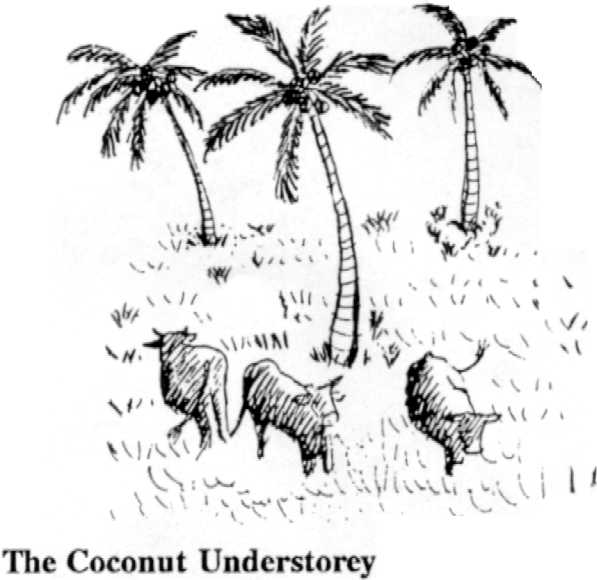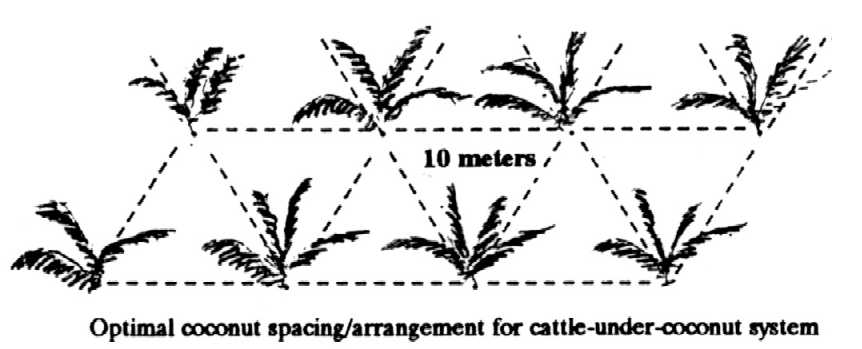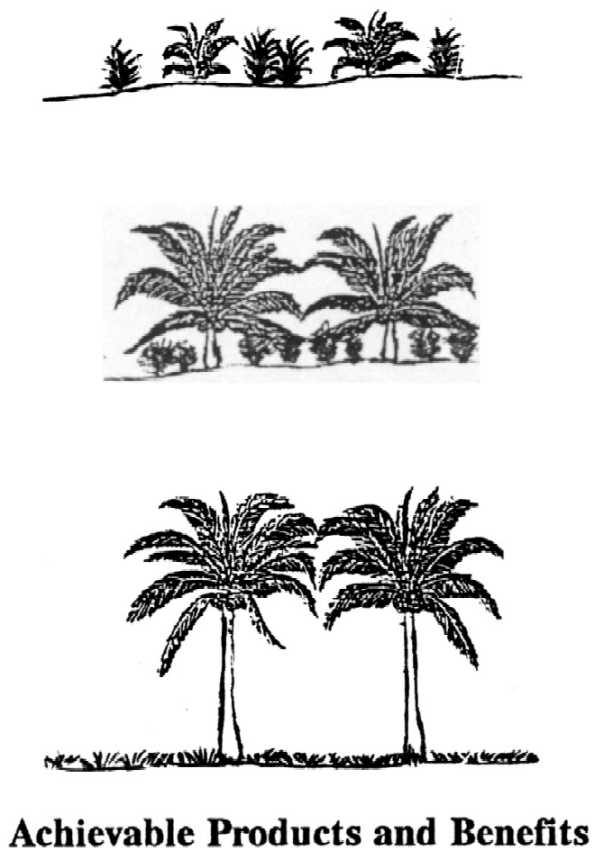
Cattle under coconuts – a practical Pacific tradition
Agroforestry for the Pacific Technologies
A publication of the Agroforestry Information Service
July 1993, Number 7
Coconuts are the most widely grown perennial crop in the Pacific. Unfortunately, an erratic world copra price and the rising cost of mechanized cultivation have together led to the neglect and poor condition of millions of hectares of land under coconut throughout the region. Large areas of senile plantations are not being replanted primarily because farmers can no longer justify their investment of scarce labor and capital given the risk and uncertainty they now attach to the industry.
Work to address this problem has centered on the breeding of hybrids that can out-yield local “talls” by 3 to 4 times (Opio 1987). The availability of these productive hybrids will surely increase the economic viability of many coconut farms. If farmers continue to focus their efforts only on increasing coconut yield, however, they will remain dependent on a single primary export product subject to an unpredictable international market. Many coconut farmers can increase the profitability of their operations while reducing risks, by adopting or improving upon a common traditional coconut farming practice.
 The Coconut Understorey
The Coconut Understorey
Traditional methods of increasing the productivity of coconut plantations all consist of alternative uses for the coconut understorey. Coconut trees are fairly long-lived (60 to 80 years), tall and widely spaced. The land beneath the coconuts receives a good amount of sunlight throughout most the plantation’s life. Pacific islanders have always used this resource to produce both subsistence and cash crops.
Today’s large coconut producers-the primary market suppliers-attempt to simply produce the greatest number of coconuts at the lowest cost possible. Of all the problems faced by these large market suppliers, controlling weeds is by far the most difficult and expensive (Plucknett 1974).
All coconut farmers must deal with the problem of how to manage the land beneath the coconuts. If left untended, the understorey is taken over by shrub and grass weeds, which compete aggressively for limited soil water and nutrients. When weeds takeover, coconut yields decline drastically.
Traditionally, coconut producers used cattle as “sweepers” or “brushers”, to keep grass and weeds short-and thus prevent nutrient and moisture competition (Reynolds 1988). The animal protein, manure and income derived from the animals, were considered extra bonuses. (Vergara and Nair 1985). Few farmers have managed coconuts and cattle together in an attempt to optimize the productivity of the system as a whole.
Opio (1987) reports that, given world copra prices, income from local “tall” plantations declines rapidly after year 35 and, by year 40, will no longer generate a profit. The opportunity cost of keeping older coconuts outweighs the benefit unless the land underneath is intercropped with short-term cash crops or intergrazed with cattle.
All over the Pacific, cattle graze in the understorey of coconuts. Given the large percentage of land area involved, there is a huge need and potential for the development and improvement of this relatively unexplored traditional technology. The objective of the “cattle-under-coconut” agroforestry strategy should not simply be to reduce coconut management inputs-or to replace nut production with livestock products. The objective should be to optimize the productivity and stability of the whole system. Pacific coconut farmers would benefit tremendously from the development of practices that most successfully integrate pasture, coconut and cattle production.
Pasture Establishment and Management
The establishment and maintenance of an good herbaceous ground cover in the coconut understorey can provide livestock feed, while also preventing the invasion of non-nutritious, yet aggressively competitive weeds. A healthy ground cover can also reduce soil erosion and increase rainwater infiltration and storage and thus the supply of water to the entire system. It is true that pasture plants usually deplete soil moisture for a period shortly after their establishment. Average soil moisture content then actually tends to rise above previous levels because of reduced runoff and greater infiltration (Plucknett 1974). Leguminous plants offer an additional bonus they fix atmospheric nitrogen, adding it to the system either as animal feed or as soil-enriching green manure. Many legumes remain green and palatable during drought periods when grasses dry out, providing a more continuous and reliable feed supply. The inclusion and/or encouragement of legumes in any pasture mix is always recommended.
Useful Pasture Species. Forage legumes that do well in the coconut pasture system include centro (Centrosema pubescens), calo (Colopogonium mucunoides) and cowpea (Vigna unguiculata). Recent work in Vanuatu demonstrates that Desmodium ovalifolium, a tropical legume commonly used as a cover crop in oil palm and rubber plantations, is. also a promising pasture addition.
Grass species suitable for the coconut understorey are relatively short, sod forming, stoloniferous and, of course, shade-tolerant. They should provide a moderate carrying capacity, allow for quick fallen nut location, are inexpensive and easy to establish from cuttings, compete well with aggressive weeds, maintain a balance with companion legumes under grazing, and do not compete excessively with coconuts (Reynolds 1988). Popular choices are cori grass (Brachiaria miliformis), palisade (B. brizantha), para (B. mutica), koronovia (B. humidicola), signal (B. decumbens) and guinea (Panicum maximum).
Correct species choices are made according to a number of environmental and management factors. In some soils, choices may be very few. On coastal coralline sands and atoll soils, koronovia and siratro (Macroptilium atropurpureum) are the only species that have done well under experimental conditions (Gutteridge and Whiteman 1978). Frequency and duration of drought may also limit selection. Centro has proven itself to be especially drought tolerant.
“Local” versus “Improved” Pasture. The conversion of local to improved pasture is usually a very slow and costly process. The extensive site preparation normally required may damage shallow coconut roots. Improved pasture is not a prerequisite for a profitable cattle-under-coconut enterprise. It is true that the productivity and quality of local pastures can be extremely variable, especially during periods of drought. However, where the local pasture contains a high percentage of legumes such as Mimosa pudica and Desmodium heterophyllum, some fertilizer additional one can make beef production viable (Reynolds 1988).
Yield “Trade Offs”. In most cases, the assumed trade-off between pasture (cattle) and coconut yield proves to be rather one-sided.
Pasture herbage production and shade density are closely correlated. A reduction in pasture yield even forage/grass digestibility is likely in shaded conditions (Reynolds 1988). On the other hand, intercropping with perennial, short-term, or cover crops rarely affects the yield or growth of the coconut crop adversely. Coconut yield often actually increases when pasture or other crops are cultivated in the understorey. Yield increases are attributed largely to practices that benefit the system as a whole, such as fertilization. A “clean” understorey also makes for easier recovery of fallen coconuts.
Pasture plants do compete for limited soil nutrients and water, particularly N, P and K. This competition can be controlled with proper grazing management and a good pasture mix. Still, regular applications of nitrogen and phosphorus fertilizer are usually necessary.
Pasture yield reductions due to coconut shading can be minimized by selecting grass and legume species that are relatively shade-tolerant. Cori grass appears, in fact, to perform better in the shade than in the open (Reynolds 1988). Shading does seem to affect the growth of tropical grasses more than legumes (Ludlow et al. 1974).
A plowing or disking each fourth year or so is advised for any pasture. This will prevent excessive soil compaction from animal traffic. The shallow cultivation of coconut land to about 25 cm-also prunes the uppermost coconut roots. This is reported to stimulate the roots which then tend to explore the deeper soil layers (Asghar 1987).
Coconut Establishment and Management
Spacing and Arrangement. The most important management tool in achieving optimal overall system productivity is appropriate coconut spacing. It is the density of coconuts per hectare that determines how much sunlight will get through to the understorey. The optimal spacing for good overall pasture and coconut production is reported to be 10 x 10 m on flat or gently rolling terrain and 9 x 9 m on slopes (Guzman and Allo 1975; Opio 1987). One can compare this to the recommended spacing for maximum nut production alone on flat land which is 8 x 8 m. Nair (1979) estimates that even at this spacing, only 20% of the total soil area under the coconuts is effectively utilized by their roots.
A triangular-as opposed to square-spacing arrangement is now recommended by most experts because it allows for more coconuts, more canopy interlock/overlap, and thus more effective interception of sunlight at any given spacing. One would suspect, then, that a square arrangement is preferred where pasture production is an objective. With a square arrangement, more light reaches the understorey pasture. However, this extra light is concentrated through wide gaps in the canopy so that some spots in the pasture receive much more light than others. Because uniformity of growth and species mix is one goal of pasture management, the triangular arrangement is still be preferred here. Coconuts in this arrangement, shade the ground more uniformly.

The Age Factor. A stand of coconuts casts varying degrees of shade depending upon its height and thus its age. In young plantations, plenty of light reaches the ground. Shading gradually increases until the palms are about 10 years old. Thereafter, understorey sunlight gradually increases to a maximum level when the palms are approximately 20 years old. It may be best to plant different crops in the understorey at these different coconut growth stages. Options will be discussed later.
Fertilizer. Spot application of potassium (muriate of potash) at the coconut stem is often recommended. This nutrient is much more important to coconut than it is to pasture plants. The usual method is to place the potash in a few shallow holes around the stem of each coconut.
Livestock Management
Cattle do best in cool weather. Heat has a greater affect the well being of most cattle breeds than any other climatic factor (Plucknett 1974). Rising body temperature suppresses animal metabolism causing lack of movement, loss of appetite, and a marked reduction in productivity (Guzman and Allo, 1975). In the tropics, the temperature under coconut shade can be as much as 6° C cooler than in the open. Cattle thus benefit from the presence of coconut palms overhead.
Cattle nutrition. With the appropriate species mix and cattle stocking density, pastures in the partial shade of coconuts can provide adequate feed. Pasture under the relatively open, mature stand, can produce five weight gains and milk yields comparable to those from pasture under open conditions (Reynolds 1988).
Grazing control. Proper grazing control is the key to any productive livestock operation. In the coconut system, grazing can be used both as a tool both to maximize pasture yield, and to minimize competition between the pasture plants and the coconuts for soil nutrients and moisture. The regular and properly timed grazing of top growth can greatly reduce excessive pasture plant transpiration and thus competition for water. Cattle recycle plant biomass and return nutrients to the system in organic manure.
Grazing control is especially important for “local” pasture. Local pasture vegetation can often prove just as productive as improved pasture mixes, with a well monitored rotational grazing program, some seeding of leguminous forage species, and an occasional addition of N, P and K fertilizer.
Potential problems. Cattle must usually be kept off coconut plantations until the palms are at least 5 years old. Otherwise the animals will chew fronds, stunting growth. They can also kill a young palm if they damage or remove the growing point.
Another potential problem is the gradual compaction of soil by trampling. One preventative practice is disking every 4 to 5 years (Guzman and Allo 1975). Again, this will also stimulate coconut root function if limited to the upper 30 cm.
The rhinoceros beetle (Erects rhinoceros) has a tendency to make its home where there is a lot of cattle dung. Free ranging cattle may thus increase the incidence of this serious coconut pest.
System Design Recommendation
There are periods during the coconut life cycle when grazing and/or pasture production are not feasible due to possible seedling damage or dense shading. For this reason, pasture block rotation is obviously the most suitable management regime. There are basically three stages in the coconut growth cycle. During each of these stages, the understorey can be used differently to the greatest advantage. In this way, the entire system is steadily maintained at optimal productivity.
- Stage 1: 0 to 5 years. Cattle must be kept off to prevent damage to young coconuts. Plenty of sunlight reaches the ground between the coconuts. Sun-loving forage crops can be raised as “cut and carry” animal feed. Alternatively, more light-demanding food crops can be grown, such as chilies, cabbage, cassava and ginger.
- Stage 2: 5 to 20 years. Pasture productivity will be relatively low due to dense shading. More shade-tolerant food/cash crops can be grown, such as cacao and kava.
- Stage 3: 20 years till coconut replacement. Ideal conditions for pasture and cattle production.
The lengths of these coconut growth phases are determined by the cattle breed and growing environment. They can be shortened or lengthened to suit management goals, size of the herd, size of pasture and other factors.
The farmer can incrementally convert the different blocks to improved pasture or introduce improved coconut hybrids, as able, or in response to market trends and opportunities.
 The following are achievable returns from the management of coconuts and livestock together, as interacting components of one system:
The following are achievable returns from the management of coconuts and livestock together, as interacting components of one system:
- Increased overall farm income
- Increased coconut yields
- More efficient use of sunlight, soil and water
- Increased food production
- Understorey weed control
- Organic fertilizer input (manure)
- Stability through diversification
- Prolonged economic life of the plantation
- Better animal health
System Limitations
The management of cattle and coconuts together is a more complex undertaking than simply managing each as a separate enterprise. The farmer must be prepared to address the following possible problems:
- Cattle damage to young palms
- Reduced pasture production
- Soil compaction and erosion
- Coconut root damage
- Introduced coconut pests: rhinoceros beetle
- Lack of adequate management skill
In many areas, there may be other, more appropriate or necessary uses for the coconut understorey. Where population densities are extremely high and land area very scarce such as on many atolls food production must be the priority. Many nutritious food crops produce well as coconut intercrops.
On many of the larger islands, however, where coconut plantations cover extensive areas, understorey maintenance is still considered a cost. The successful conversion of this cost into a profit can make many marginally uneconomic operations viable again.
Research Needs
There is a need for research to identify good pasture species combinations, optimal coconut stand densities, and appropriate spatial and temporal arrangements in a variety of environments. Further screening and evaluation of shade-tolerant pasture species that will not compete aggressively with coconut palms would assist interested farmers immensely. Promising species must then be tested under various cutting, grazing and fertilization regimes. Economic studies comparing the cattle-under-coconut system to cattle and coconut production as separate enterprises are also long overdue.
Further Reading
Asghar, M. 1987. Coconut intercropping: physico-chemical constraints and soil fertility implications. In M. Asghar, S.C. Ooi and D.F. Osborn, Eds. Proceedings of the Fifth South Pacific Regional Meeting on Agricultural Research, Development, Extension and Training in Coconut. Alafua: IRETA, USP, pp. 94-104
Guzman, M.R. and Allo, A.V. 1975. Pasture production under coconuts. Taipei: ASPAC/FFTC.
Ludlow, M.M., Wilson, G.L. and Heslehurst, M.R. 1974. Studies on the productivity of tropical pasture plants versus the effect of shading on the growth, photosynthesis and respiration in two grasses and two legumes. Aust. J Agric. Res, pp. 425-33.
Nair, P.K.R. 1978. Plant community interactions in crop combinations with coconuts. In Proceedings of the Intemational Conference on Cocoa and Coconuts. Kuala Lumpur (Malaysia): Malaysian Agricultural Research and Development Institute and the Incorporated Society of Planters, pp. 606-620.
Nair, P.K.R. 1979. Intensive multiple cropping with coconuts in India: principles, programmes and prospects. Advances in agronomy and crop science No. 6. Berlin: Verlag Paul Parey, 147 pp.
Opio, F.A. 1987. Coconut intercropping and rotational grazing potential in the South Pacific. In M. Asghar, S.C. Ooi and D.F. Osborn, Eds. Proceedings of the Fifth South Pacific Regional Meeting on Agricultural Research Development, Extension and Training in Coconut. Alafua: IRETA, USP, pp. 82-93.
Plucknett, D.L. 1974. Managing pastures and cattle under coconuts. Westview Tropical Agriculture Series 2. Boulder, CO (USA): Westview Press.
Reynolds, S.G. 1988. Pastures and cattle under coconuts. FAO Plant Production and Protection Paper 91. Rome: FAO
Vergara, N.T. and Nair, P.K.R. 1985. Agroforestry in the South Pacific region: An overview. Agroforestry Systems. 3,pp. 363-79.
The Agroforestry Information Service is jointly supported by the US Forest Service Tropical Forestry Program and the Nitrogen Fixing Tree Association
Prepared by K.R. Dalla Rosa, Program Director for the Pacific, NFTA
Published by the Agroforestry Information Service (AIS) of the Nitrogen Fixing Tree Association (NFTA)
A publication of the Forest, Farm, and Community Tree Network (FACT Net)
Winrock International
Email: forestry@msmail.winrock.org
